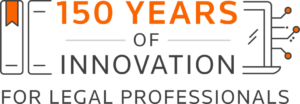Thomson Reuters Celebrates 150 Years: Jon Meyer on Shaping the Law of Tomorrow

Thomson Reuters is commemorating 150 years of customer partnership and innovation to honor the 1872 founding of John B. West Publisher and Book Seller. West’s innovative spirit lives on in Westlaw – a product that still carries his name – and in the AI-driven products and legal research technology tools used by legal professionals worldwide.
Our Legal Current series features voices across Thomson Reuters sharing how West’s legacy of customer partnership and innovation endures today. We hear today from Jon Meyer, director of Reference Attorneys, Operations Customer Service & Support, who has worked at Thomson Reuters for 16 years.
“The modern era of our support”
Meyer’s most memorable moments include the 2010 launch of WestlawNext.
“It was impactful because of the move to global search and a more powerful plain-language algorithm,” he said. “And the reason it stands out was it was the beginning of what I would call the modern era of our support. Almost overnight, the questions that we received became more sophisticated.”
Meyer noted AI helped with customers’ “easier-to-answer questions.”
“But as we were working with customers with WestlawNext, the inquiries became more complex,” he explained. “We needed a heightened degree of knowledge for both the product and the legal background. WestlawNext was a key shift, and everything else on top of that has been a welcome advancement.”
Prioritizing customer collaboration
As head of the Reference Attorney group, Meyer sees West’s legacy of customer partnership play out daily.
“We help our customers shape the law of tomorrow with and in the work that we do,” he said. “That is directly in line with John B. West’s aims all those years ago; the legacy that he set up plays out every day. We’re helping customers with the questions that they have. We’re educating customers on the products so that they can better utilize them and see the value they get.”
Meyer’s team members also share what they hear from customers across Thomson Reuters.
“We promote the voice of the customer and make sure that we’re listening to customers so that we can continue to see products evolve and their experiences improve,” he said. “We constantly hear what customers like, what presents challenges for them, and how we can make things better. Sharing it helps Thomson Reuters focus on continuing to be a customer-driven organization.”
“The collaboration that we have in our role is critical,” Meyer added. “It’s true whether you’re talking about product development or a reference attorney contact. We see it every day in the latter, where it’s really important for us to listen to customers and understand what their needs are, and to create experiences that resonate with them. If we get it right, we can build trust and stronger relationships with customers to become an even more integral and invaluable part of the way that they work. Ultimately that benefits the entire market.”
 Efficient, dynamic, and simple
Efficient, dynamic, and simple
Meyer characterized the evolution of the legal space during his tenure as “efficient, dynamic, and simple.”
“Working efficiently and using our time wisely is important, and that’s especially true of attorneys,” Meyer said. “They’ve got a lot on their plate and several things they have to move through each day, so being efficient in all parts of their practice is important. And if they do it well, being efficient ultimately allows them to compete better in the legal world – and that’s what they care about most.”
He noted how the pandemic has shaped the legal industry’s reputation as slow to adopt technology.
“I think that was true,” Meyer said. “But spurred on by the pandemic, we are certainly seeing attorneys embracing technologies faster. And in doing so, they’re realizing, ‘hey, I can actually do this, and it can make my practice better.’ If attorneys are more open to that as a way to operate, it creates some cool opportunities to meet those new and evolving needs with the work that Thomson Reuters does.”
He said another factor shaping legal professionals’ adoption of technology is their use of technology as consumers in their personal lives – and expectations for simplicity, ease of use, and fast resolution of any issues that arise.
“As those experiences continue to evolve in their consumer life, they’re going to have an expectation that Thomson Reuters is doing it on the professional side,” Meyer said. “It puts a greater impetus on us to remove complexity in the way that we work because it will help us stand out as partners rather than an entity that doesn’t remove those challenges.”
From a customer-service perspective, Meyer predicts the next big thing will involve better surfacing of data “between the lines.”
“We have seen this with litigation analytics, where we are surfacing information that is not clear on its face,” Meyer explained. “As analytics in general grows and informs the decisions we make in almost every part of our lives, attorneys will have that same expectation for their work. With that data that can exist between the lines, there’s a real tactical advantage that that can be gained, where attorneys can make better and more informed choices that will help them be successful. Thomson Reuters can be that dynamic partner that shows customers what’s possible and what exists in a world that otherwise they wouldn’t see – pulling it together with the massive amount of data and content that we have.”
Read more perspectives on the Thomson Reuters legacy and watch Legal Current for additional stories in the coming weeks.